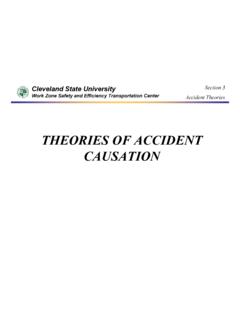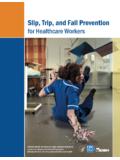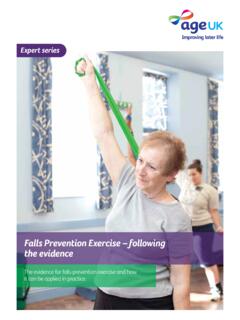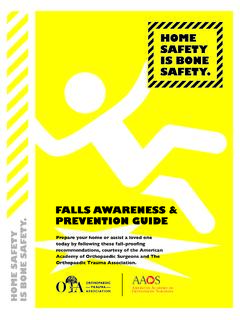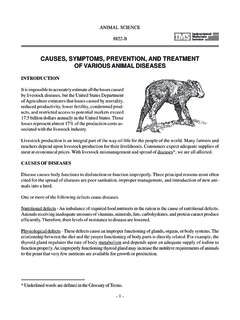Transcription of Understanding COMAH Competent Authority for the Control …
1 Page 1 of 28 Control of Major accident HazardsCompetent Author ity f or the Control of Major accident HazardsPurpose statement Con trol of Major accident H azardsthe Competent AuthorityCyfoeth Naturiol CymruNatural Resources WalesUnderstanding COMAHA guide for new entrantsHealth and Safety ExecutiveUnderstanding COMAH : A guide for new entrants Page 2 of 28 ContentsIntroduction 3 Using this guidance 4 How the Competent Authority regulates business under COMAH 5 Duties relevant to all COMAH sites Notification 6 Hazardous substances consent 8 Prepare a major accident prevention policy (MAPP) 10 All measures necessary 12 Duties relevant to top-tier COMAH sites only Prepare a COMAH safety report 13 Prepare and test an on-site emergency plan 16 Supply information to local authorities for off-site emergency planning purposes 17 Provide certain information to the public 18 Appendix 1 How the COMAH Regulations apply to your business 19 Appendix 2 Summary of duties for new entrants into COMAH 25 References 27 Further information 28 Health and Safety ExecutiveUnderstanding COMAH .
2 A guide for new entrants Page 3 of 28 IntroductionThis guidance is aimed at businesses that are expanding their operations and may consequently become subject to the Control of Major accident Hazards Regulations 1999 ( COMAH ) as either a new lower-tier or top-tier COMAH site, or move from lower to top-tier status. It sets out the basic duties for new entrants into COMAH regulation or to top-tier status to enable businesses handling a range of dangerous substances to plan for the transition and meet the additional responsibilities under the guide also applies to businesses affected by changes to the qualifying thresholds under COMAH due to, for example, the reclassification of a dangerous businesses in Great Britain are legally required to protect their employees, third parties and members of the public who may be affected by their work activities. There are also various legal requirements that apply to protect the environment.
3 When an accident occurs, having significant quantities of flammable, environmentally hazardous or toxic substances on site increases the potential to cause multiple injuries or fatalities to those working on site or living in the local community and/or cause damage to the environment. The COMAH Regulations aim to prevent major accidents and, should one happen, require businesses to limit the effects on people and the environment. The simplest COMAH requirements apply to lower-tier COMAH operators. These businesses must consider the potential for a major accident arising from their work activities and describe their approach to controlling the risks in a major accident prevention policy (MAPP).Additional COMAH requirements apply where businesses increase their inventories of dangerous substances above the relevant top-tier COMAH threshold. Top-tier COMAH operators should plan for the changes carefully and ensure they make appropriate revisions to their systems for managing and controlling related that are already meeting their responsibilities to manage health and safety and environmental protection effectively will be well placed to meet the additional requirements of COMAH and Safety ExecutiveUnderstanding COMAH : A guide for new entrants Page 4 of 28 Using this guidanceDetermine whether the COMAH Regulations apply to your siteRefer to Appendix 1 How the COMAH Regulations apply to your business to determine if sufficient quantities of dangerous substances are (potentially) present on site to make the establishment subject to the COMAH 1 contains an extract from Schedule 1 of the COMAH Regulations which lists the relevant dangerous substances for COMAH and the rules for determining your inventory.
4 More detailed information is provided in A guide to the Control of Major accident Hazards Regulations 1999 (as amended): Guidance on Regulations L111 (see ).Establishments that are or will become subject to COMAHThis document outlines the basic duties for all COMAH sites and additional duties that top-tier COMAH sites have. A summary of the information is also provided in Appendix 2 Summary of duties for new entrants into COMAH .Businesses that are considering increasing their inventories of dangerous substances can learn more by contacting their local Competent Authority inspection team (see Further Information at the end of this guide) who can provide further advice to enable informed decision making based on what the changes might mean in practice and how best to manage the transition quickly and sitesThe COMAH Regulations do not apply to non- COMAH sites but remember that duties under relevant health and safety legislation will apply.
5 Also, for non- COMAH sites where HSE finds non-compliance with health and safety legislation, costs may be recovered via Fee For Intervention (see ).Non- COMAH sites must also comply with the environmental legislation relevant to their operations. Many of the practical pollution prevention measures necessary under COMAH are also required under other legislation, though in a manner proportionate to the risk. For more information see:England Health and Safety ExecutiveUnderstanding COMAH : A guide for new entrants Page 5 of 28 How the Competent Authority regulates business under COMAH COMAH establishments are regulated by the COMAH Competent Authority (CA), comprising the Health and Safety Executive (HSE), the Environment Agency, Natural Resources Wales (NRW) and the Scottish Environment Protection Agency (SEPA).Under the COMAH Regulations, the CA has statutory responsibility to provide regulatory oversight of high-hazard industries using or storing quantities of dangerous substances that fall into the scope of the approach therefore aims to assure the public that onshore major hazard businesses are meeting their responsibilities to Control major accidents to people and the environment and to mitigate the consequences in the event of an industrial statutory functions under COMAH include assessing safety reports and major accident prevention policies, organising a system of inspections of COMAH establishments, and investigation and reporting on major CA leaflet Understanding COMAH : What to expect from the Competent Authority ( ) describes how the CA regulates the UK onshore major hazards industry in Great Britain and what businesses can expect from CA inspectors at their establishments.
6 It provides advice and information on how you can prepare for an inspection so it can be conducted efficiently and effectively. It also provides an overview of how the CA recovers its costs under the COMAH and Safety ExecutiveUnderstanding COMAH : A guide for new entrants Page 6 of 28 Duties relevant to all COMAH sites NotificationWhy you need to notifyThe COMAH Regulations aim to limit the consequences of a major accident to people, local communities and the environment so it is important that regulators and emergency planning authorities are made aware of certain increases in the quantities of dangerous substances on the increased quantity of dangerous substances on site equals or exceeds COMAH thresholds it is a legal requirement that you inform the COMAH Competent Authority (CA) of the change this is called a COMAH to notifySites generally enter into scope of the COMAH Regulations in one of two ways: a business decides to expand and increase its inventory of dangerous substances.
7 Or external factors result in one or more of the COMAH qualifying thresholds being met or exceeded (for example, reclassification of a substance as dangerous to the environment). Table 1 provides a summary of the timetable for COMAH notifications to be 1 Timetable for COMAH notifications * Start of operation means the point at which the site s inventory of dangerous substances first meets or exceeds the COMAH threshold limit. Reason for entering COMAH Notify the Competent Authority Proposed construction of a new 3 6 months before construction begins establishment, quantities of dangerous substances equal to or in excess of 3 6 months before start of operation relevant COMAH thresholds If details in pre-construction notification The newly constructed site were missing or have changed Existing non- COMAH site chooses In reasonable time before the start of to increase its inventory of dangerous operation,* eg 3 6 months substances Existing non- COMAH site enters due to Within 3 months of the change change in: - dangerous substance classification; or - COMAH Schedule 1 threshold limit.
8 Or - knowledge about dangerous substances generated during loss of Control Health and Safety ExecutiveUnderstanding COMAH : A guide for new entrants Page 7 of 28 What to put in a COMAH notificationThe key points which have to be included in the notification are: name and address of the COMAH operator; address of the establishment; name or position of the person in charge of the establishment; details of dangerous substances present (or likely to be present*) on site; quantity and physical form of those dangerous substances; brief description of site activities related to the dangerous substances; features of the environment which could lead to a major accident on the site; elements of surrounding environment which could make the consequences of a major accident worse. * Likely to be present eg inventory variations which may occur because of seasonal demand, fluctuations in business activity etc, or dangerous substances which may be present sometimes but not at other times.
9 Also includes dangerous substances which may be generated during the loss of Control of an industrial chemical process. Full details of notification requirements are given in Schedule 3 to the COMAH Regulations (see A guide to the Control of Major accident Hazards Regulations 1999 (as amended): Guidance on Regulations L111).How to notify the Competent AuthorityThere is no special form to use for the notification; however, you can freely download and use the notification template provided by the CA (see ): Part A: should be used for statutory information required by the CA; Part B: is for non-statutory information and statutory information which you do not want to be placed on the Public Register. Before completing this form you are advised to discuss the information required by contacting your local HSE or Environment Agency/SEPA/NRW the notification to the CA either by email or post and HSE will pass on the details to the relevant environment partner within the Notifications, HSE Hazardous Installations Directorate CEMHD, Redgrave Court, Merton Road Bootle, Merseyside, L20 7HS HSE will acknowledge receipt of your notification within 10 days.
10 If we have not met this deadline please contact us by phone (0151 951 4694) or email and Safety ExecutiveUnderstanding COMAH : A guide for new entrants Page 8 of 28 Hazardous substances consentWhat is hazardous substances consent?If you are about to become a COMAH site top tier or lower tier you will need to obtain a hazardous substances consent. The consent is a planning Control that enables a hazardous substances Authority (HSA) to consider whether the presence of a significant quantity of a hazardous substance is appropriate having regard to the risk to the a separate regulatory process from COMAH , we recommend that you make consent applications in parallel to COMAH preparatory work (this will also save you time).For specific information on the legislation that underpins hazardous substances consent you should contact your local HSA but for more general queries see:England The local HSA grants hazardous substances consentWhen an application for hazardous substances consent is made, the local HSA is responsible for deciding whether it is granted or refused.










